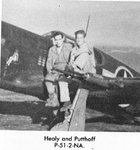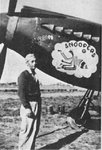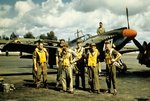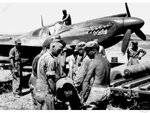IdahoRenegade
Airman 1st Class
The success of the 2-stage/2 speed Merlin equipped P-51Bs and later models is well documented and justifiably famous. I'm fairly familiar with it's combat success from December '43 on, as are most casual aviation enthusiasts. I believe most know the plane was developed as a result of a British purchase order. This order was somewhat out of desperation, with the British being desperate for more fighters, most any fighters, with the original contact with NAA being a request to build P-40s-in spite of its limited performance. NAA engineers offered to develop what became the P-51 instead and the results are history.
While I'm pretty familiar with the results of the Merlin Mustangs, what I haven't found is a great deal of discussion of the early, Allison equipped British birds (MK-1s?) equipped with single stage superchargers. Does anyone have any sources discussing the use/performance of this plane by the British and how it fared against the opposition, as well as how it compared to its British contemporaries? What theaters did it operate in? I understood (anecdotally anyway) that it performed well at lower altitudes compared to the Spit in terms of speed, being significantly faster at the same power level due to the low drag airframe (true or am I mistaken?). I also believe that even in the early variations with no rear fuselage tank that it had a considerable range advantage over the Spit due to it's lower drag airframe. Did it also carry significantly more fuel even in this variation, and was it used to a significant extent over occupied Europe?
Similar questions concerning the US utilized P-51A model. Where was it utilized and how did it well did it succeed at it's missions. I know virtually nothing about the A-36 dive bomber version. "Version" perhaps not being accurate-was this basically a '51 with dive flaps or were the changes more extensive? How did it perform in that roll? It seems like a plane with a single liquid cooled engine would be pretty susceptible to loss in that role, given the susceptibility of the cooling system to damage. Was the A-36 produced due to it's performance, or more as a way to keep the NAA production line in operation?
Finally-the story of the Mustang being re-engined at Rolls with the Merlin is well known-but I know nothing of the details. Any information on the backstory? Who's idea was it, when did it happen, reviews of the test flights? Other than the prototypes retrofitted at Rolls, were any production Mustangs built for the British before the US P-51B model went into production?
Sorry about all the basic questions. Compared to the vast amount of knowledge so many here have, I'm just a rookie. Thanks.
While I'm pretty familiar with the results of the Merlin Mustangs, what I haven't found is a great deal of discussion of the early, Allison equipped British birds (MK-1s?) equipped with single stage superchargers. Does anyone have any sources discussing the use/performance of this plane by the British and how it fared against the opposition, as well as how it compared to its British contemporaries? What theaters did it operate in? I understood (anecdotally anyway) that it performed well at lower altitudes compared to the Spit in terms of speed, being significantly faster at the same power level due to the low drag airframe (true or am I mistaken?). I also believe that even in the early variations with no rear fuselage tank that it had a considerable range advantage over the Spit due to it's lower drag airframe. Did it also carry significantly more fuel even in this variation, and was it used to a significant extent over occupied Europe?
Similar questions concerning the US utilized P-51A model. Where was it utilized and how did it well did it succeed at it's missions. I know virtually nothing about the A-36 dive bomber version. "Version" perhaps not being accurate-was this basically a '51 with dive flaps or were the changes more extensive? How did it perform in that roll? It seems like a plane with a single liquid cooled engine would be pretty susceptible to loss in that role, given the susceptibility of the cooling system to damage. Was the A-36 produced due to it's performance, or more as a way to keep the NAA production line in operation?
Finally-the story of the Mustang being re-engined at Rolls with the Merlin is well known-but I know nothing of the details. Any information on the backstory? Who's idea was it, when did it happen, reviews of the test flights? Other than the prototypes retrofitted at Rolls, were any production Mustangs built for the British before the US P-51B model went into production?
Sorry about all the basic questions. Compared to the vast amount of knowledge so many here have, I'm just a rookie. Thanks.











